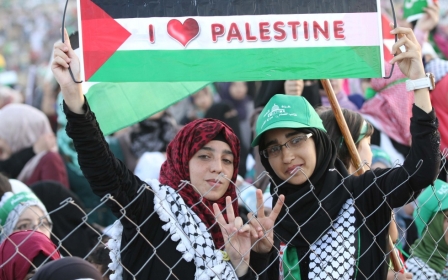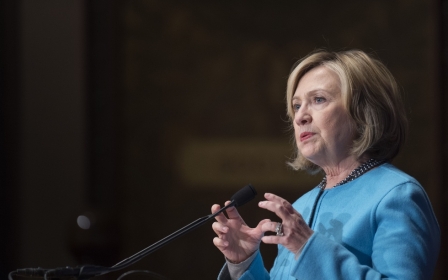Israel’s looming gas empire requires a final solution in Gaza

“The destruction which I have seen coming here is beyond description,” said UN secretary-general, Ban Ki Moon, after his October tour of the Gaza Strip.
Operation Protective Edge, Israel’s military incursion into Gaza this past summer, wrought an unprecedented level of devastation on the tiny strip of land inhabited by 1.8 million people. The operation had damaged or destroyed over 100,000 homes, affecting more than 600,000 Palestinians - a third of the population.
Mowing the grass
“Basically the town is unliveable,” said Mayor Mohammed al-Kafarna about Beit Hanoun. “There is no power, water or communications. There are not basics for life.” One major sewage pipe serving nearly half a million people had been severed, sending huge quantities of raw sewage into the sea and on fields.
In 2012, a UN report warned that Gaza “will not be liveable by 2020”. The following year, Israel’s tightening of its blockade prompted Filippo Grande, commissioner-general of the UN Works and Relief Agency (UNWRA), to say that “Gaza is quickly becoming uninhabitable.”
Israel’s massive bombardment of Gaza this summer has fast-tracked that outcome. This is no accident. While Israeli officials will not admit it, this strategic goal can be surmised from the statements of those close to key officials in Netanyahu’s administration.
Dismantling Gaza
“The only durable solution,” wrote Martin Sherman in the Jerusalem Post during the summer onslaught, “requires dismantling Gaza, humanitarian relocation of the non-belligerent Arab population, and extension of Israeli sovereignty over the region”: a recipe for ethnic cleansing and colonisation. He complained that the elected Israeli government is constrained by an unelected “left-wing” political discourse wedded to “the two-state concept and the land-for-peace doctrine,” both of which must be rejected.
For Sherman, the current strategy of periodically “mowing the grass” – “a new round of fighting every time the Palestinian violence reaches levels Israel finds unacceptable” – must be replaced by a final solution: “The grass needs to be uprooted – once and for all.”
Sherman is no pariah. On the contrary, his ideas increasingly represent the thinking of senior Israeli cabinet officials. As founding director of the Israel Institute for Strategic Studies (IISS), an initiative dedicated to laying “the foundations of a new assertive Zionist-compliant paradigm,” Sherman’s platform is endorsed by the following key Israeli leaders: Yaakov Amidror, Israel’s national security adviser until 2013; Uzi Landau, minister of tourism and ex-minister for energy; and Moshe Ya’alon, vice prime minister and incumbent defence minister.
Colonisation
These connections reveal critical elements of Israel’s security strategy. Amidror, for instance, has long advocated that Israel directly occupy Gaza “for many years,” to prevent a situation where “Hamas is strengthened into an entity similar to Hezbollah.”
His successor, Yossi Cohen, who presided with Ya’alon over Operation Protective Edge and who has previously served as deputy head of Shin Bet (Israel’s domestic security agency), told Israeli Army Radio that the operation had successfully created conditions that would facilitate the Palestinian Authority’s (PA) return to power in Gaza at Hamas’ expense. Hamas needed to be “demilitarised”, he said.
Israeli foreign minister Avigdor Lieberman agreed: “As long as Hamas controls Gaza, we won’t be able to ensure the safety of Israel's citizens in the South and we won't be able to make a peace agreement.” Earlier during the latest invasion of Gaza, Lieberman recommended that Israel consider re-occupying Gaza to end rocket attacks.
Palestinian statehood: A threat to Israel’s energy hegemony?
Another Sherman endorser, Uzi Landau, who is currently minister of tourism, was minister for energy and water from 2009 to 2013. There he oversaw Israel’s resource policies, especially concerning gas discoveries and export options. In 2011, when the PA was bidding to secure formal UN recognition of Palestinian statehood, Landau told Israeli radio that Israel should unilaterally declare its sovereignty over the Jordan Valley, West Bank settlements, and all of Gaza to head off the bid. He had previously been dispatched by the foreign ministry to Chile, Colombia and Australia to lobby against the PA campaign.
Why would Landau, then energy and water minister, be sent to lobby against Palestinian statehood?
In recent years, Israel had made increasingly significant energy discoveries throwing light on the link. In December 2010, the Texas based energy company Noble energy announced that it had discovered 25 trillion cubic feet of gas in the offshore Leviathan field (downgraded more recently to 17 trillion). This followed the US Geological Survey’s (USGS) assessment earlier in the year of an estimated 122 trillion cubic feet of technically recoverable gas in the Levant basin, encompassing the waters of Israel, Syria, Lebanon, Cyprus and Gaza. This is “bigger than anything we have assessed in the United States,” said a USGS spokesperson at the time.
Landau’s advisers: Israel’s gas could deplete in decades
The new discoveries would turn Israel into a gas-export powerhouse, with potentially transformative implications across the region. But there were potential pitfalls.
In 2012, the chief scientists of Landau’s energy and water ministry warned the government that Israel did not have sufficient gas resources to sustain both exports and domestic demand. Citing a gap of “100 to 150 billion cubic metres between the demand projections that were presented to the committee and the most recent projections,” they said that Israel’s “gas reserves are likely to last even less than 40 years!"
By 2055, the chief scientists argued, even if Israel chose not to export any gas, it would entirely exhaust its offshore reserves. But if Israel exports significant quantities of gas, and if it turns out that much of its gas turns out to be not commercially extractable, then the breaking point could arrive decades earlier. “The more gas we use now, the sooner we'll need to start importing gas or oil or to find alternative technology.”
Landau and his colleagues obviously took the report seriously enough that, according to Ha'aretz, they excluded the report’s findings from the committee determining Israel’s gas export policy.
Threat of war
Complicating matters further, many of the recently discovered oil and gas resources Israel is claiming for itself are in disputed territorial waters where maritime boundaries are not clearly defined.
In the summer of 2010, Landau said that Israel would “not hesitate to use force” to protect its offshore gas discoveries. He was responding to claims that Leviathan’s deposits extend into Lebanon’s territorial waters.
Similarly, two offshore fields that Israel is already exploiting have been claimed by the Palestinian Authority to extend into Gaza's offshore territory – Mari-B, which is near depletion, and Noa North, both of which are being developed by Noble Energy.
Gaza’s gas: The key to peace?
In March 2014, just a few months before the IDF launched Operation Protective Edge in Gaza, the German Marshall Fund of the United States published a policy brief on Israel’s interests in Gaza’s gas fields by Simon Henderson, director of the Gulf and Energy Policy Program at the Washington Institute for Near East Policy (WINEP) in Washington DC. WINEP is notable for its influence amongst US foreign policymakers. Current and former WINEP members have had senior roles in successive US administrations, including Obama's, and its alumni have gone onto serve across various US government agencies on Middle East policy.
Henderon’s policy brief in particular pinpointed the Gaza Marine, where just over 1 trillion cubic feet of gas was discovered by BG Group in 2000. Gaza Marine could supply all of Palestinian power for up to 20 years. Although the election of Hamas in 2006 in Gaza left negotiations over the gas between Israel and the PA at a stalemate, according to Henderson: “In late 2011 and early 2012, there was renewed Israeli interest in devising a way to exploit the natural gas of Gaza Marine.”
International diplomatic interest further increased in 2013, with Quartet Middle East envoy Tony Blair and US secretary of state John Kerry seeing the Gaza Marine as integral to a potential peace package. In October 2013, Israeli officials conceded that the Israeli government was “very supportive” of the project. All this is corroborated by British Foreign Office files released under Freedom of Information.
Israel’s vision for the Gaza Marine includes a range of options. Apart from boosting PA revenues dramatically, “Using Gaza Marine gas may also reduce the need of Israel to consume its own natural gas to generate electricity for the Palestinians,” observed Henderson. “Such usage will also marginally lower Israel’s dependence on fields controlled by the Noble Energy/Delek group, which currently holds the licenses for the Tamar field and all the other Israeli fields likely to come on stream in the next few years.”
Gaza’s gas, Henderson continued, “would be available for transfer into Israel’s natural gas main network, feeding power stations and petrochemicals across the country.” The gas could also be used for Gaza’s power plant, or even to power the West Bank. In the latter case, “the Gaza Marine natural gas would be fed to an Israel power plant to generate electricity. That electricity would then be supplied to the West Bank.”
Gaza’s gas: The key to exports?
But there is another dimension to the strategic significance of the Gaza Marine: Israel’s gas ambitions. This was alluded to by Ariel Ezrahi, senior energy adviser in Tony Blair’s Office of the Quartet Representative in east Jerusalem, who noted that the biggest obstacle to Israel becoming a regional gas exporter is the opposition of domestic Arab populations in Jordan, Egypt, Turkey and elsewhere.
This opposition could, however, be overcome if Israel finds a way to integrate Gaza’s gas into the export equation, so that Arab publics find a way to see gas deals with Israel as acceptable: “… it would be wise for Israel to at least consider the contribution of the Palestinian dimension to these deals,” said Ezrahi. “I think it’s a mistake for Israel to rush into regional agreements without at least considering the Palestinian dimension and how it can contribute to Israeli interests.” Israel should use the Gaza Marine “as an asset as they strive to join the regional power grid, and as a bridge to the Arab world,” by selling Palestinian “gas to various markets,” or promoting a deal with the corporations developing Israel’s “Tamar and Leviathan [fields] that will allow for the sale of cheap gas to the [Palestinian] Authority.”
Hamas: The obstacle
For Israel, the existence of Hamas remains the chief obstacle to any of these scenarios. According to Simon Henderson: “The main challenge to Secretary Kerry’s vision is that the Gaza Marine natural gas field is offshore the Gaza Strip, controlled by Hamas, whose authority is not recognised by the PA, which is based in Ramallah. Additionally, the United States regards Hamas as a terrorist organisation and Washington is therefore legally constrained from cooperating with it.”
In other words, from the perspective of Israeli hawks and the entities of the Quartet - the US, EU, UN and Russia - the fundamental obstacle to both the proposed ‘peace package’ and Israel’s interests in becoming a regional energy hegemony, is the continued existence of Hamas in Gaza.
In 2007, incumbent defence minister Ya’alon advised in an influential policy paper that there was only one way to solve this problem: “It is clear that without an overall military operation to uproot Hamas control of Gaza, no drilling work can take place without the consent of the radical Islamic movement.” Ya’alon is yet another Israeli government official who endorses Martin Sherman’s IISS initiative.
Since then, successive Israeli military operations - including Operation Protective Edge - have aimed at degrading Hamas’ power in Gaza by making the entire civilian population of the strip pay the price. Through excessive military action to devastate Gaza’s critical infrastructure until much of the strip is virtually “uninhabitable,” Israel has successfully accelerated this process.
Strangulating Gaza
Under the new ceasefire agreement with Hamas after the operation, Israel had secured even more Draconian powers to enforce its ongoing siege of Gaza. This included a partial military re-occupation by maintaining a 100 metre buffer zone inside Gaza; a joint Israeli, UN and PA committee to supervise the process for goods being permitted into Gaza; tight monitoring of imports of construction materials, as well as their use inside Gaza, to guarantee they would not be used by Hamas to build ‘terror tunnels’ and weapons; and on the table for discussion, Israel’s top priority was to make the total demilitarisation of Gaza a precondition for reconstruction and rehabilitation.
Under this extraordinary scheme, Gaza will be under constant surveillance by Israeli drones, and the PA-UN supervisory committee will submit all details of homes needing rebuilding to an Israeli database for close monitoring and approval.
Against this context, the decision by the EU General Court to remove Hamas from a list of terrorist groups along with the European Parliament’s new resolution recognising “in principle… Palestinian statehood and the two-state solution,” takes on new meaning.
To move forward, what remains of the aborted Kerry-Quartet vision for ‘peace’ encompassing the exploitation of Gaza’s gas, requires Hamas’s military capabilities – already infinitesimal compared to Israeli’s $15.5 billion military budget – to be degraded to the point of being utterly negligible.
The EU’s latest measures appear designed to incentivize the Palestinians and Hamas to comply with this vision of a pliable, demilitarised Gaza as a step toward a ‘two-state’ solution dominated and controlled by Israel: the carrot. Israel’s threat and use of force to smash Gaza into an uninhabitable no-man’s land, in which the US and the EU are complicit through extensive trade and military aid to Israel, is the stick.
- Nafeez Ahmed PhD, is an investigative journalist, international security scholar and bestselling author who tracks what he calls the 'crisis of civilization.' He is a winner of the Project Censored Award for Outstanding Investigative Journalism for his Guardian reporting on the intersection of global ecological, energy and economic crises with regional geopolitics and conflicts. He has also written for The Independent, Sydney Morning Herald, The Age, The Scotsman, Foreign Policy, The Atlantic, Quartz, Prospect, New Statesman, Le Monde diplomatique, New Internationalist. His work on the root causes and covert operations linked to international terrorism officially contributed to the 9/11 Commission and the 7/7 Coroner’s Inquest.
The views expressed in this article belong to the author and do not necessarily reflect the editorial policy of Middle East Eye.
Photo: Hamas top leader Ismail Haniya (L), spokesman for the Ezzedine Al-Qassam Brigades, Abu Obaida and Mussa Abu Marzuq (R) greet supporters marking the 27th anniversary of the Hamas movement’s creation on 14 December, in Gaza City
Middle East Eye propose une couverture et une analyse indépendantes et incomparables du Moyen-Orient, de l’Afrique du Nord et d’autres régions du monde. Pour en savoir plus sur la reprise de ce contenu et les frais qui s’appliquent, veuillez remplir ce formulaire [en anglais]. Pour en savoir plus sur MEE, cliquez ici [en anglais].





